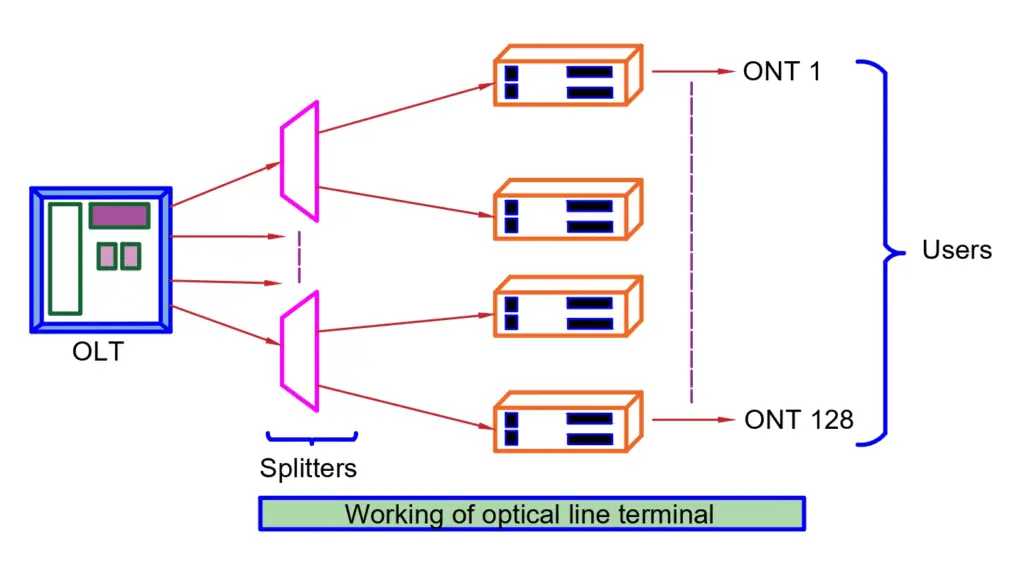An optical line terminal( OLT) is hardware that is used at the endpoint of the passive optical network. In this article, we will discuss Optical Line Terminal (OLT), its definition, features, and functions. So, let’s get started with a basic introduction.
The way of data communication through networks is revolutionized by the introduction of optical fiber technology. Optical fiber technology has improved the data transfer speed, channel bandwidth, and reliability and security of the data communication network.
In a Fiber Optic Network, a component called Optical Line Terminal (OLT) is a vital component that acts as an interface between the ISP and the subscriber. It is basically the endpoint hardware component in a passive optical network (PON).
What is an Optical Line Terminal (OLT)?
In a passive optical network (PON), the optical line terminal (OLT) is a hardware device that acts as an endpoint in the network. An optical line terminal typically has a CPU (Central Processing Unit), a passive optical network card, a gateway router, and a voice gateway uplink card.
In a fiber optic network, an optical line terminal is generally found in the service provider’s data center and acts as a communication gateway between the service provider and subscribers.
Components of Optical Line Terminal
The following are some major components of an optical line terminal (OLT):
- OLT Module – It is the key component of the OLT which converts electrical signals into optical signals.
- Uplink Interfaces – Uplink interfaces are the components that establish connections between optical line terminals and other communication networks like the Internet. Common examples of uplink interfaces are Gigabit Ethernet, PON interfaces, etc.
- Switching Fabric – This component of OLT is responsible for handling the routing and switching of data packets. It improves the data flow and traffic management.
- Control and Management Module – This component of OLT configures, controls, and manages the overall system. It performs vital functions like performance monitoring, subscriber connection management, security implementation, etc.
Functions of Optical Line Terminal
The following two are the primary functions of an optical line terminal in a passive optical network:
- It converts the standard signals of the FiOS (Fiber Optic Service) provider to the frequency signal and framing used by the passive optical network.
- Coordinates the multiplexing among the conversion devices of the optical network terminal situated in the subscriber’s premises.
Apart from these two functions, OLT performs several other important functions which are described below:
- OLT collects data from different optical network terminals and multiplexes into a single fiber link with higher capacity to optimize the bandwidth utilization of the network.
- OLT also manages the traffic according to the service requirements to improve the quality and performance levels of the network.
- OLT ensures network security and data privacy to protect these from unauthorized access.
- OLT distributes bandwidth among connected customers to ensure reliable communication.
- OLT allows service providers to manage the network, monitor the network performance, and troubleshoot faults.
Working of Optical Line Terminal
OLT receives data from the metro network and delivers the data to the user in the passive optical network(PON). The OLT can manage more than one PON at a time.
The following figure shows an OLT handling 4 separate passive optical networks at a time.

We can see in the above figure that each PON has individually 32 connections. Thus, a single OLT can deliver the data to ( 32 X4=128 )128 users.
OLT offers data communication in .the downstream and upstream. In downstream communication, the network uses a wavelength of 1490 nm and 1550 nm for data and voice signal, and video signal respectively.
In upstream communication, the network uses a wavelength of 1330 nm for data and voice signals.
The data operating speed of OLT is 155 Mb/s, 622 Mb/s, 1.25 Gb/s, or 2.5 Gb/s.
Features of Optical Line Terminal
The following are the important features of an optical line terminal (OLT):
- OLT enables high-speed data transmission through optical fiber networks.
- OLT can offer various types of services, such as data transmission, voice signal communication, video signal transmission, etc.
- OLT is able to optimize the bandwidth utilization of the network.
- OLT can accommodate the increasing number of customers and the demand for bandwidth.
- OLT provides compatibility to integrate with different vendors’ devices to establish a flexible network architecture.
Role of Optical Line Terminal in Passive Optical Network
OLT is widely used in passive optical networks (PON) to connect multiple optical network terminals (ONTs) to create a shared optical fiber infrastructure for data distribution to customers. In PON, OLT uses TDM (Time-Division Multiplexing) and WDM (Wave Division Multiplexing) to provide bidirectional communication of data between the OLT and different optical network terminals (ONTs) over the same optical fiber.
Conclusion
In conclusion, this is all about the optical line terminal (OLT) used in fiber optic networks. In PONs, OLT helps in reducing the network construction cost by providing high network bandwidth for data communication.
It is the fundamental component in an optical fiber network that allows high-speed data transmission. In fiber optic networks, OLT has become an essential component to improve network performance, and security, and provide network management capability to meet the increasing demand for the internet and other advanced network services.